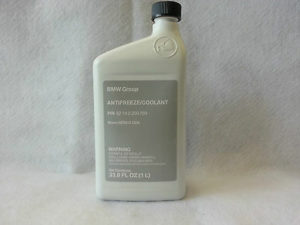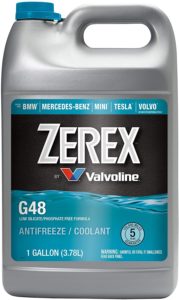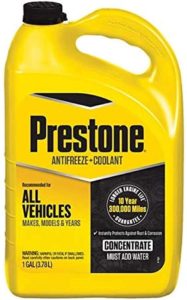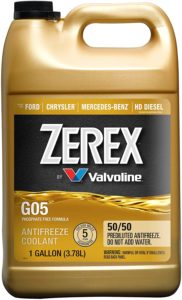Getting a good coolant for your BMW is essential – here is a comprehensive guide on buying one, as well as some great options to consider.
Any BMW owner will correctly tell you that their car was not a cheap buy; it was a considerable investment they had to put significant money into. Therefore, maintaining their purchase involved plenty of TLC and careful measures to ensure their car serves them for as long as possible, and buying the right coolant is part of that much-needed maintenance.
Similar to engine oils, getting a specific coolant for your car is a mystifying process for many novice drivers, despite its importance in keeping the car in top shape. For the best coolants, they will ensure your car parts are protected against corrosion, cools down the engine during the hotter months, and act as anti-freeze liquids in the winter.
However, BMWs are not your average car, and they require slightly different needs in their coolants, such as being free of phosphates and nitrates. If you are looking for some solutions, you have come to the best place, as we have outlined the best five options you can find.
Contents
Best coolant for BMW – Comparison table
Coolant | Best for | |
|---|---|---|
BMW 82-14-1-467-704 Grey coolant | Overall pick | |
BMW 82-14-2-209-769 coolant/antifreeze | Budget buy | |
Zerex G48 Coolant/Antifreeze concentrate | Older/vintage BMW models | |
Prestone Original AF2000/C coolant | Versatile option | |
Zerex G05 Phosphate-free antifreeze | European BMW models |
Reviews of the best coolants for BMW
-
BMW 82141467704 Grey coolant – Best overall choice

BMW 82141467704 Grey Anti-Freeze coolant, 1 Gallon
- Contains ethylene glycol and Bittering agent
- Guarantees protection for metallic components such as aluminum, steel, and cast iron
This antifreeze is among the best options for BMW models in general, and it also happens to be among the best-selling automotive engine coolants worldwide.
Its design allows it to keep the temperatures in your engine in check at all times, and protects the BMW’s water pump from erosion through lubrication. During the winter months, the coolant prevents your engine from freezing, and cools down the transmission oil coolers.
It comes in a blue color, and its genuine composition works well for all BMW models. However, it is important to note that you should not use it in its concentrated state, but instead dilute it with water in a 50/50 ratio.
Pros
- Long-lasting
- Prevents corrosion and rust in your engine
Cons
- Expensive
- Needs you to do some minor installations before using it
-
BMW 82-14-2-209-769 coolant – Best budget buy

BMW 82-14-2-209-769 Antifreeze/Coolant – Quart
- Direct fit, genuine OEM
- Ensures quality effectiveness in engine functionality
If you are looking for a high-quality coolant for your BMW without spending a fortune on it, then this option is a good one to consider. It is a smaller version of the 82141467704 antifreeze, as it comes in a one-liter packaging rather than a gallon.
Similar to other options on this list, its composition is genuine OEM, and it helps keep the coolant passages in your engine open while preventing them from premature corrosion. It is advisable to dilute it first before use, by mixing it with distilled water in a 50/50 ratio. It is great for your engine when it loses coolant to overheating issues, as well as when you service your engine.
Pros
- Great product for the price
- Appropriate for many BMW models due to its OEM composition
- Smaller size allows for easier handling
Cons
- Not intended for some models, so it is important to check with the car manual
-
Zerex G48 coolant – Best for older models

Zerex G48 Concentrate Antifreeze/Coolant 1 Gallon
- Contains between 30 and 50 ppm of denatonium benzoate as a bittering agent
- OEM approved formula that protects against freeze-ups, corrosion, and boil-overs
It is common knowledge that sticking to manufacturer-specific coolants is best for your car, but this is not always the case; it is good to also consider other coolants at times. Some coolant manufacturers have come up with products that can be useful regardless of your car model, and the Zerex G48 is a good example of this.
Thanks to its anti-phosphate and low silicate composition (less than 250 parts per million), it works well for a variety of cars, including BMWs. When you dilute it in a 1:1 ratio, it will ensure superb levels of controlled temperature regardless of whether the surrounding temperatures are summer hot or freezing cold. Additionally, mixing it in a 5:7 ration with distilled water ensures your engine and its parts are always under protection from scaling, buildup, and corrosion.
Although it is not of the HOAT variety of coolants used in most modern car models, it will work well if your BMW model is a vintage one or any other older model.
Pros
- Inexpensive
- Works well for a variety of car models, including BMW
- Formula works well for many years
Cons
- Not appropriate for some models, especially newer ones
-
Prestone antifreeze coolant – Best versatile option

Prestone Original AF2000/C Antifreeze coolant, 1 Gallon
- Free of nitrates, borates, phosphates, and silicates
- Designed to give the engine 150,000-mile protection
If you are looking for an antifreeze that ensures delivery on all fronts, it is hard to beat the Prestone All-Vehicle antifreeze/coolant. It is another case of advocating for usage of coolants outside your car model, and it does a superb job on that front, as its design allows it to work with multiple vehicles regardless of their make, model, or year of manufacture. With a rating of 150,000 miles or 5 years, it will serve you well for quite some time.
Unlike most options on this list, it comes pre-diluted and ready for use thanks to the mixture of 50% demineralized water and 50% antifreeze coolants. This is a unique combination that will offer anti-freezing protection even if temperatures drop to as low as -34 degrees. The water in use is also mineral-free, which reduces the chances of deposit formation in the engine and prevents failure of the water pump.
It will also protect the rubber components from cracking, and is a good choice for cars that have pressure caps on their radiators. It also includes Prestone ‘Cor-Guard’ corrosion inhibitors, which prevent rusting and other forms of corrosion.
Pros
- Long lasting
- Ideal choice for many cars
- Comes pre-mixed, so it is ready for use
- Quite affordable
Cons
- None noted so far
-
Zerex G05 Coolant – Best for European BMW models

Zerex G05 Phosphate Free 50/50 Prediluted Antifreeze/Coolant, 1 GA
- Additional convenience through coming pre-mixed
- Freeze protection down to -36OC
Similar to all other Zerex products, this coolant comes from Valvoline and uses the famous HOAT technology (Hybrid Organic Acid Technology) to make it a worthwhile choice for aluminum radiators. Its composition allows for protection against corrosion and rust, and its formula makes it work equally well for both diesel and gasoline engines.
Its formula is based on phosphate-free European technology and a reduced pH, which protects all the metallic elements in your engine cooling system from corrosion – including aluminum parts. Its silicate composition is very low, and it is 100% phosphate-free, allowing it to offer protection when you need to protect your cooling system from radiator failure, corrosion, and rust.
The coolant ensures protection for 150,000 miles or 5 years, which is quite impressive compared to most brands. Zerex coolants come pre-mixed and this is no exception, with the ratio being at 50/50 so you will not need to add water to it.
Pros
- Great for diesel and gasoline engines
- Inexpensive
- HOAT-type coolant
Cons
- May not be ideal for select models, so it is important to check with your car model manual
Buying guide for the best BMW coolants
What is a coolant and why is it important?
Coolants are important liquids, and they serve to keep your engine at optimal temperatures for its operations. Heating within a car’s engine is inevitable; the components are moving fast and against each other, and the friction they create generates heat – if you fail to cool down the engine, these components will wear down and result in other consequences like a smoking engine or the car breaking down.
Car coolants, which are also referred to as antifreeze, stop the overheating process from occurring through lubricating the components, and preventing damage of the piston timing, cylinder, head gasket, and water pump. All coolants use glycol compounds as a base, with some adding water to the mix.
Some benefits that come with using high-quality coolants for your BMW include:
- Prevention of corrosion: Using the best coolant ensures that your engine is getting the best additives, which help in prevention of corrosion in the inner engine components and foaming. Regular flushing of the liquid will also flush scale deposits and rust out of the system, which tend to build up over time.
- Temperature regulation: Manufacturers pay close attention to the mixing of coolant and distilled water in their products, and this ensures your engine is protected during the heat transfer process. Unlike plain water, antifreeze products do a better job of dissipating more heat, although water can act as a temporary solution if you have no access to the liquid.
- Makes system contaminants harmless: Your car’s engine components will lose their anti-corrosive properties as the car ages, and this increases contaminant levels. Using a good coolant renders them harmless and flushes them out.
- Extends the lifespan of the water pump: All the best coolants for your BMW will include additives that increase the water pump durability through lubrication.
- Solves leakages: Some antifreeze solutions can also solve leakage issues in your engine, which saves you money and time from making frequent radiator replacements.
Differences between coolant types
There are three major varieties of coolants in the market today, and they are HOAT (Hybrid Organic Acid Technology), OAT (Organic Acid Technology), and IAT (Inorganic Acid Technology). Each type has its own attributes and works better for specific car models while not working well for others, and the choice you make depends on your car model and other car-specific factors.
- IAT coolants: These are green in color, and are ethylene-glycol based. Although coolants are generally considered harmful to the environment, IAT-type coolants are the most toxic of them so you must use them carefully, and this is due to the ethylene-glycol composition. While it is good for a short time, covering about 30,000 miles on average, it eventually becomes too acidic and you will need to change it.
- OAT coolants: These are the organic variant of IAT coolants, with the difference being the addition of additives that increase the time between system flushes, as well as reduction in anti-corrosive properties. Unlike IAT coolants, their base consists of PG, or Propylene Glycol, which is a slightly less toxic ingredient compared to ethylene glycol. They can come in several colors, ranging from blue, pink, orange, and dark green.
- HOAT coolants: These are the most recent form of coolants in the market, and are derivatives of OAT coolants with the distinction of having more anti-corrosive properties. If you own high-end car models like BMWs and newer car models, this is the best type of coolant to use because of its elimination of phosphates and silicates, as well as other compounds that can be deemed harmful to the engine components.
Factors to consider when choosing a coolant
The safest criteria you should consider when choosing coolants is keeping your driving conditions in mind, as well as consulting your car owner’s manual, manufacturer, or dealership. In general, here are some factors to consider, which will also apply to other car models:
What does the source say?
The manual that comes alongside your car will give you the information you need on maintenance, including the coolant you should use. If you lack a copy of your owner’s manual, you can find the information online, thanks to the power of the internet.
All the formulas that your owner’s manual and dealership will suggest will likely be OEM (original equipment manufacturer) approved, although there are some aftermarket coolants you can use.
Check the color
Different coolant colors will generally correlate with different car compatibilities; for instance, HOAT coolants are usually yellow or orange while IAT coolants are green. However, bear in mind that colors are not entirely accurate indicators of the right coolant for your car, although you can use it as a general guideline. Instead of just using its color, read the specifications on the bottle to ensure it is a good fit for your vehicle.
Do not forget water
When changing or adding coolant to the car, ensure you read the bottle to check if the formula requires mixing with water or not. Some coolants do not require mixing and you can pour them directly in the car’s system, while others need mixing with water.
Temperature range
This is among the most crucial factors to consider before buying an antifreeze, as the best radiator coolants also depend on the environments you drive in. Some coolants will work best in extreme weather and seasonal conditions compared to others.
For instance, if you are driving in an area that frequently experiences temperature drops below 34 degrees Fahrenheit, it is best to get an antifreeze with a 60-40 or 70-30 coolant to water ratio. The more the antifreeze in the mixture, the lower the solution’s freezing point.
FAQs
How often should you change a coolant?
This depends on the car model you use. Changing the coolant is important to prevent corrosion of the engine parts, although the frequency will depend on what the car manufacturer specifies. A general rule to use though is changing it every 50,000 miles, with some car models requiring servicing of the coolant when they attain 10,000 miles.
Can I refill coolant in my engine myself?
Yes, you can, although there are some steps you should follow if you decide to fill it yourself. Ensuring you are using the right coolant is the first step, turn off the engine and set the gear to a neutral or parking state, and make sure your arms face away from the cooling fans even if the engine is off. Always allow the engine to cool down before removing the coolant reservoir cap, and then remove the cap using a thick cloth or towel because the cap is still under pressure.
How long should I wait to start the car after adding coolant?
You can run the engine immediately to drive out any remaining air in the system and reduce the chances of damage due to air expansion occurring faster than the coolant’s expansion.
Conclusion
While there is no coolant brand that is perfect for your BMW car over any other, your choice depends on the model you own and its specifications. Regardless of your specific BMW model, always aim to get the best coolant you can find, and it will help preserve the integrity of your engine in the long term.

